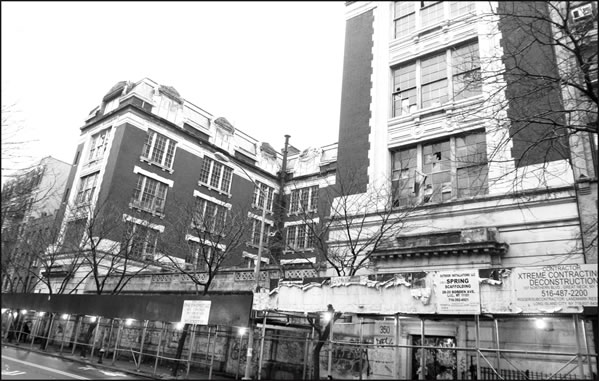By Lincoln Anderson
Old P.S. 64 owner now just trying to rent building
A rumor was recently circulating in the East Village that developer Gregg Singer had leased the old P.S. 64 building on E. Ninth St. to the Art Institute of New York City for dormitory use.
That would represent a major change in Singer’s plans for the property, on which he has long wanted to build a towering, profit-driven dormitory, though been stymied repeatedly by the city and the courts in his efforts.
A.I.N.Y.C. has a floor in the Trinity Real Estate-owned building at 75 Varick St. and another campus location on Beach St. in Tribeca; the school offers courses in graphic design, fashion design, interior design, video production and interactive media, among others.
Michael Rosen, of the East Village Community Coalition and a resident of the Christodora House condo tower, next door to the old school building, said he would think the East Village is a bit too far from Tribeca and that A.I.N.Y.C. should respect neighborhood residents’ wish that 605 E. Ninth St. — the former CHARAS/El Bohio cultural and community center — be restored as a community center.
But Joe Pirrello, dean of student affairs for A.I.N.Y.C., when asked if his school had signed a lease for the old P.S. 64, said no.
“That old public school?” Pirrello said. “They have sent us a proposal. We don’t have the bodies.”
In short, the dean said, the Art Institute has 1,100 students, but currently houses only 200 of them; sixty students live in Stuyvesant Town at 14th St. and First Ave., while the other 140 have rooms in the former St. George Hotel at 100 Henry St. in Brooklyn Heights.
The institute received the proposal about four months ago, he said. Singer pitched them a lease, but it was not very long term, Pirrello indicated.
“Yeah, I think it was 10 years,” Pirrello said. “We never pursued it because we don’t have the need.”
Asked how many students Singer had proposed housing in the old building, Pirrello didn’t give a figure.
“I think it was by floor,” he said. “He had offered us whatever we wanted.”
As for whether Singer had offered the institute space in a planned dormitory tower or within the existing building, Pirrello said, “It was not a high-rise — it was a renovation of the existing building.”
As for why Singer had approached A.I.N.Y.C., Pirrello said, “I think he was looking for anyone.”
So Singer appears to be trying to reuse the existing building to generate some income, at last. He has been unable to develop the property and use it in the more than 10 years since he bought it for $3.15 million at an auction of city-owned properties.
The city’s Department of Buildings denied Singer the right to build his dorm tower, saying he must first show the project has an affiliation with an educational institution. Otherwise, D.O.B. argued, the building might not end up being used as a dorm. Singer would have used the community-facilities zoning allowance to build the dorm tower, enabling it to have extra height.
Singer has fought the institutional-affiliation requirement at the Board of Standards and Appeals and in court, but, except for one win at the Appellate Division level, has lost every time.
On March 25 of last year, the Court of Appeals, the state’s highest court, unanimously reversed the Appellate Division and upheld Buildings and the B.S.A. on the institutional-affiliation requirement. The court opinion said: “It would create needless problems if the developer built a 19-story building only to find that he could not use it in a legally permitted way. The city would then face a choice between waiving the legal restrictions and requiring the building to remain vacant or to be torn down.”
More recently, Singer lost at the State Supreme Court level on two others suits: In one, he was suing the city for $100 million in monetary damages, and in the other he was trying to reverse the school building’s landmarking, which occurred years after he purchased the property.
“I’m confident that there’s no tower there,” Rosen said of Singer’s apparent scrapping of his 19-story, high-rise plan. “They always have the option of going to Landmarks and asking for a little bit of space — but I would hope that would not happen.”
More to the point, Rosen said, “There are many in the community that hope the building would be returned to community use. A dorm for a school in Tribeca is not a community use.”































